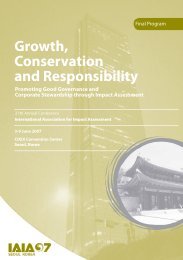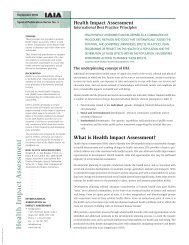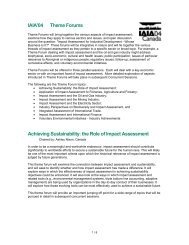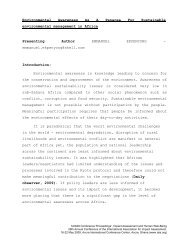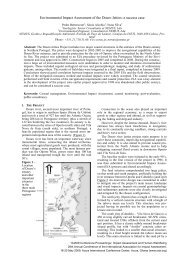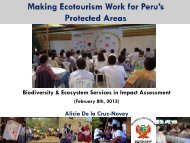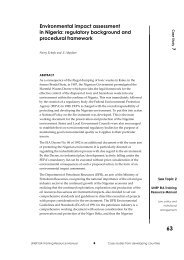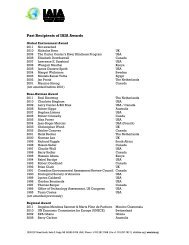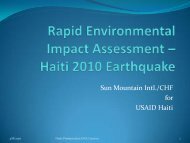Power, poverty and sustainability - International Association for ...
Power, poverty and sustainability - International Association for ...
Power, poverty and sustainability - International Association for ...
You also want an ePaper? Increase the reach of your titles
YUMPU automatically turns print PDFs into web optimized ePapers that Google loves.
• IAIA06 Abstracts Volume •<br />
CS 17.1 Environmental law <strong>and</strong> economic development policies<br />
........................................................................................................77<br />
The Use of the Ug<strong>and</strong>an Legal <strong>and</strong> Policy Systems to Address<br />
Environmental <strong>and</strong> Social Safeguard Issues in the World Bank<br />
<strong>and</strong> African Development Bank Projects....................................77<br />
<strong>Power</strong>, Poverty <strong>and</strong> Sustainability: The Role of Environmental<br />
NGOs <strong>and</strong> Voluntary <strong>Association</strong>s in Environmental Litigation in<br />
South Africa ...............................................................................78<br />
Beyond SEA <strong>and</strong> EIA: Greening Regional Development<br />
Programme–Environmental Integration into Structural Funds ...78<br />
CS 17.2 Environmental law in practice <strong>and</strong> regulation<br />
management..................................................................................78<br />
Writing Environmental Impact Management Law: A South<br />
African Perspective.....................................................................78<br />
Institutionalizing Mitigated FONSIs: Another Step Away from<br />
the Precautionary Principle.........................................................78<br />
Trial of Including EA in Project Appraisal System in Lao PDR 79<br />
Putting Policy into Practice: The Opportunities <strong>and</strong> Challenges<br />
of the Richtersveld L<strong>and</strong> Claim..................................................79<br />
CS 17.3 Comparing national EA systems ...................................79<br />
Comparing EIA Procedures <strong>and</strong> Contents in Kenya, Tanzania,<br />
Mozambique <strong>and</strong> EU..................................................................79<br />
Strengthening EIA: The Case of Central America.....................79<br />
Cultural Heritage in Environmental Assessment: Current Practice<br />
<strong>and</strong> Future Developments in NW Europe...................................80<br />
A Critical Appraisal of EIA Screening Practice in EU Member<br />
States ..........................................................................................80<br />
CS 17.4 The future development of EA <strong>and</strong> practice.................80<br />
Environmental Assessment in Canada: The Next Generation ...80<br />
Modernizing EIA Implementation in the United States–A Status<br />
Report .........................................................................................80<br />
The Relationship Between the EU EIA <strong>and</strong> SEA Directives......81<br />
The Water Framework Directive, Assessment, Participation, <strong>and</strong><br />
Protected Areas: What are the Relationships? ...........................81<br />
CS 17.5 Transboundary impact assessment ...............................81<br />
Aligning Russian <strong>and</strong> Norwegian EIA processes–A Prerequisite<br />
<strong>for</strong> Joint Environmental Evaluation of Barents Sea Offshore<br />
Petroleum Operations?................................................................81<br />
The EIA as Part of <strong>International</strong> Trade Agreements–Example:<br />
North American Free Trade Agreement (NAFTA) Operations? 82<br />
Phase 1B of the Lesotho Highl<strong>and</strong>s Water Project: A<br />
Transboundary Impact Assessment Case Study .........................82<br />
CS 18.1 The Marrakech Action Plan <strong>and</strong> follow-up..................82<br />
Building Awareness of IA Capacity Building Among Decision<br />
Makers........................................................................................82<br />
Identifying <strong>and</strong> Adopting Effective Approaches <strong>for</strong> Capacity<br />
Building......................................................................................82<br />
CS 18.2 The Marrakech Action Plan <strong>and</strong> Follow-up.................83<br />
Review of the Status of the Marrakech Declaration <strong>and</strong> Action<br />
Plan.............................................................................................83<br />
Criteria <strong>for</strong> Assessing Good Practices in IA Capacity Building .83<br />
CS 18.3 The Marrakech Action Plan <strong>and</strong> Follow-up.................83<br />
Experiences from <strong>International</strong> Collaboration on Capacity<br />
Building through the First Ever Distance Learning Course on<br />
SEA <strong>for</strong> China ............................................................................83<br />
The CBBIA Program..................................................................83<br />
Capacity Building in EIA <strong>for</strong> Mexican NGOs............................83<br />
CS 19.1 SEA Development in Asia ..............................................84<br />
SEA, Environmental In<strong>for</strong>mation, <strong>and</strong> National Development<br />
Planning: Policy Linkages in the Kingdom of Bhutan...............84<br />
The Trend of SEA Movement in Japanese Local Governments .84<br />
Comparative Study of SEA-Like Approaches in Japan ..............84<br />
Using Environmental Assessment to Overcome Financial<br />
Barriers to Renewable Energy Options ......................................84<br />
CS 19.2 EIA Development in Asia...............................................84<br />
Environmental Economic Impact Assessment in China:<br />
Problems <strong>and</strong> Prospects..............................................................84<br />
Regional Environmental Assessment <strong>for</strong> Sanitation <strong>and</strong><br />
Sewerage ....................................................................................85<br />
Streamlining the Environmental Impact Assessment (EIA)<br />
Process in Indonesia ...................................................................85<br />
Is EIA Follow-up Casting a Shadow on Open Cast Coal<br />
Mining in India?.........................................................................85<br />
Analyzing Impacts of Bioenergy Expansion in China Using<br />
Strategic Environmental Assessment .........................................85<br />
CS 20.1 Urban development: How IA contributes to<br />
(local) capacity building <strong>and</strong> decision making (I) ......................86<br />
Mixed Use Outline Planning Applications–What<br />
Constitutes Good Practice in the UK? ........................................86<br />
“Auroville–The City the Earth Needs”: A Successful Case<br />
of an Innovative <strong>and</strong> Integrated Sustainable Development.........86<br />
Ecophysiographic Study <strong>for</strong> More Environmental Spatial<br />
Planning .....................................................................................86<br />
Evaluation of the Salubrity of Briqueterie in Yaounde-<br />
Cameroon ...................................................................................86<br />
CS 20.2 Urban development: How IA contributes to<br />
(local) capacity building <strong>and</strong> decision making (II).....................87<br />
DPWH Policy Responds to the Challenges of<br />
Environmental Sustainability Through a Three-Phase<br />
Strategy on Environmental Governance.....................................87<br />
Indicator-Based Sustainability Assessment of Housing <strong>and</strong><br />
Settlement Structures within the Metropolitan Area of Ho<br />
Chi Minh City ............................................................................87<br />
Strategic Transport Management as a Regional<br />
Development Competence..........................................................87<br />
The Importance of Impact Assessment as a Tool to Improve<br />
Development Planning in Developing Countries .......................87<br />
Multiple Criteria Decision Making Analytic Hierarchy<br />
Process <strong>for</strong> Environmental Assessment of Urban<br />
Underground Infrastructure........................................................88<br />
CS 21.1 Capacity building <strong>and</strong> networking in developing<br />
countries (I)...................................................................................88<br />
Building on Success Factors: A Capacity Development<br />
Model <strong>for</strong> Environmental Management in Viet Nam .................88<br />
CBBIA: The Asian Way............................................................88<br />
Strengthening Environmental Assessment Professional<br />
Capacity in Africa ......................................................................88<br />
CS 21.2 Capacity building <strong>and</strong> networking in developing<br />
countries (II) .................................................................................89<br />
Capacity Building <strong>for</strong> Impact Assessment in Mongolia .............89<br />
EIA as a Tool <strong>for</strong> Capacity Building in Tanzania.......................89<br />
Developing Air Quality Impact Assessment Capacity in<br />
Africa through Institutional Building .........................................89<br />
CS 21.3 Challenges of IA in developing countries<br />
(Roundtable) .................................................................................90<br />
CS 22.1 Integrated assessment of trade-related policies ...........90<br />
How Useful are Computable General Equilibrium Models<br />
<strong>for</strong> the Sustainability Impact Assessment of Trade-Related<br />
Policies? .....................................................................................90<br />
NAFTA Ex Post Assessment of Trade Liberalization <strong>and</strong><br />
Policy Integration: Reviewing the Evidence .............................90<br />
Assessing the Impact of Trade Impact Assessments ..................90<br />
EA of Trade: Recent Activities <strong>and</strong> the Challenge of<br />
Follow-up ...................................................................................91<br />
10


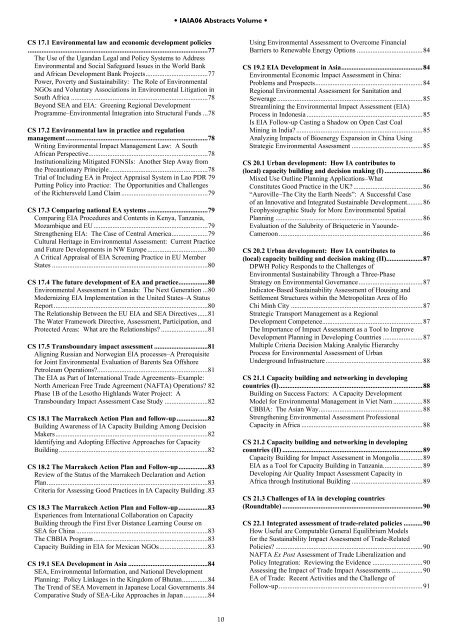

![Session Report [PDF] - International Association for Impact Assessment](https://img.yumpu.com/22416146/1/190x245/session-report-pdf-international-association-for-impact-assessment.jpg?quality=85)
![Session Report [PDF] - International Association for Impact Assessment](https://img.yumpu.com/22416140/1/184x260/session-report-pdf-international-association-for-impact-assessment.jpg?quality=85)
